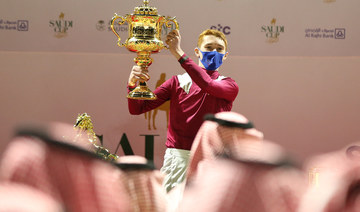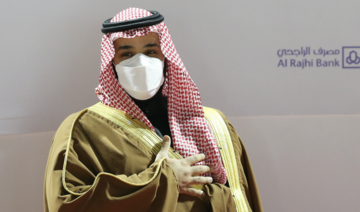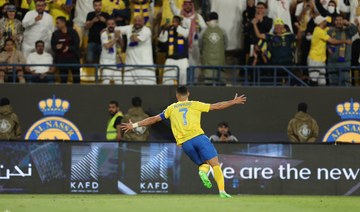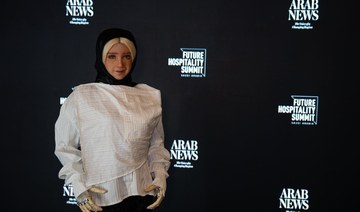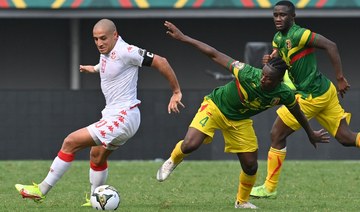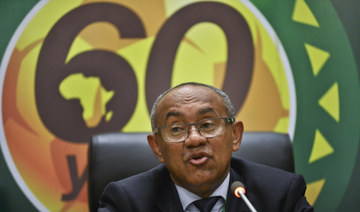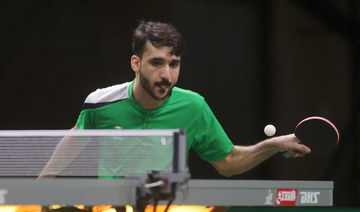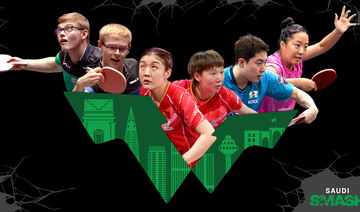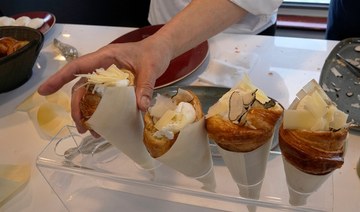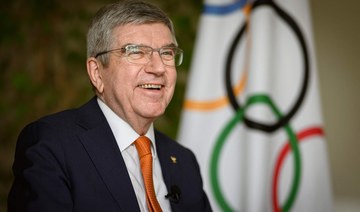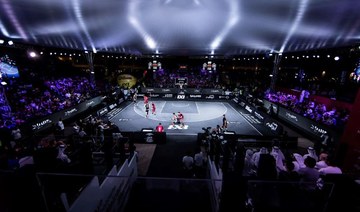RIYADH: The smile on Adel Al-Fouraidi’s face said it all.
The Saudi rider had just won the last of the four International Jockeys Challenge races to secure second place overall on the first day of the Saudi Cup weekend.
Riding Zhabi Al-Hammad, Al-Fouraidi romped home ahead of the rest of the strong 14-jockey field, having finished second in the second Jockeys Challenge earlier.
“It means a lot to me to represent all Saudi jockeys,” he said, barely concealing his glee. “She was a favored filly, a good filly, and she helped me a lot to win this race.
“It’s hard to describe the feeling. I felt that everyone was with me. It was a dream come true.”
But things were about to get even better for the local boy.
The following day, as the eyes of the racing world turned to the $30.5 million Saudi Cup, the world’s richest horse race meeting, Al-Fouraidi found himself in the spotlight again.
First, he rode Saudi horse Mubasher Al-Khalediah to victory ahead of stablemate Mutwakel Al-Khalediah in the US $2 million Obaiya Arabian Classic, the richest race in the world for purebred Arabians.
For the second day running, the television cameras caught an elated Al-Fouraidi.
“I thank God for this win. I cannot describe this feeling,” he said. “The race started very fast, but I took my time with this horse because I had ridden him before, and slowly I picked up the pace. In the end, it worked for me and we won.”
To cap a memorable personal weekend, Al-Fouraidi then rode Great Scot — owned by Prince Faisal bin Khalid — to third place in the showpiece $20 million Saudi Cup. A $2 million prize is the stuff of dreams for a jockey few had heard of days earlier.
Naturally, the focus on Saturday night was on the winner of the $10 million top prize, Mishref, ridden by David Egan, trained by John Gosden and owned by Prince Abdul Rahman bin Abdullah Al-Faisal.
And for good reason. A superlative race by Egan saw him steer Mishref to an unexpected victory over the favored American horse Charlatan, trained by the legendary Bob Baffert.
But the real legacy of the Saudi Cup could well be the establishment of a thriving, sustainable horse racing industry driven by the country’s own talent.
This was not an event that simply relied on importing the best international practitioners. Saudi involvement was ubiquitous.
The International Jockeys Challenge, in which riders are assigned horses prepared by Saudi-based trainers, pits 14 international male and female jockeys against each other in four races worth $400,000 each.
But the Jockeys Challenge day is also intended to boost local participation in line with Saudi Arabia’s Vision 2030, with four other races taking place throughout the afternoon.
On Friday, horses from Bahrain, Spain and the Czech Republic were left behind by Petrus — trained by Fawaz Al-Ghareeba — who emerged victorious at the inaugural running of the $500,000 Saudi International Handicap sponsored by Al Rajhi Bank.
Meanwhile, the Imported & Local Bred Handicap, the Local Bred Fillies Open and Friday’s final race, the Local Bred Horses Open, all provided other Saudi jockeys and trainers a share of the spotlight.
Beyond the races, awards and top prize money, it was a welcome sign of changing times to see how every aspect of the Saudi Cup was carried out by local talent, both male and, significantly, female.
From the volunteers, some clearly still in their teenage years, directing the arriving cars and buses, to the golf buggy drivers, security personnel, media center staff and ushers — all were local, professional and courteous.
While having the finest international talent perform at your doorstep is no doubt inspirational, involving local students and young adults in such programs and events provides a tangible way for Saudis to be introduced into the horse racing industry.
From the Saudi Cup, more competitions and racing programs will emerge according to Amr Zedan, member of the Saudi Equestrian Authority and the owner of Zedan Racing Stables in Kentucky, US.
The Saudi Cup, he told Arab News earlier this month, “is reinventing the way racing is done from a regional perspective, and internationally as well.”
He also highlighted the Kingdom’s geography and climate as factors in promoting equestrian activities all year round.
“Saudi Arabia is very unique in many ways. We don’t have a single season,” Zedan said. “We have Taif, for instance, where the weather is very pleasant during the summer, so we can have racing meetings there during the off-season. Then we have the on-season, which is the winter-spring. So Saudi Arabia is very unique in that regard, and I know that the Saudi Equestrian Authority has ambitious plans to create a full-on ecosystem to develop equestrian sports in general and racing in particular.”
All the conditions are there to succeed, as Al-Fouraidi and many others showed at the 2021 Saudi Cup. It’s time for young Saudis to take the reins.
Saudi Cup’s real legacy will be the rise of local talent
https://arab.news/zb384
Saudi Cup’s real legacy will be the rise of local talent
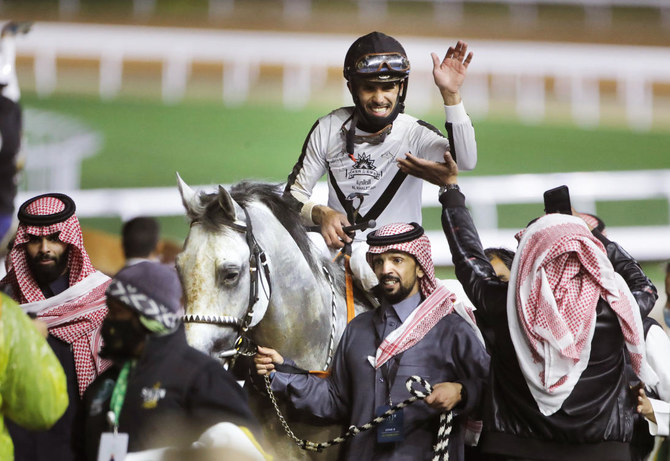
- Success of $10 million winner Mishref, jockey Al-Fouraidi and host of other owners and trainers highlighted rising Saudi involvement
- Al-Fouraidi rode Saudi horse Mubasher Al-Khalediah to victory in the US $2 million Obaiya Arabian Classic
Cristiano Ronaldo’s sister describes Saudi Arabia as ‘safest place on earth’

- Katia Aviero posts message on Instagram in which she says of the Kingdom: ‘If there is a safe place to walk alone, it is here’
- Aviero, who joined her brother’s partner, Georgina Rodriguez, to watch him play in the King’s Cup semifinal on Wednesday adds: ‘Nobody disrespects you here and there are no thefts’
RIYADH: While Al-Nassr star Cristiano Ronaldo was busy scoring a brace on Wednesday in a 3-1 victory over Al-Khaleej that earned his team a place in the King’s Cup final, his sister was praising Saudi Arabia and describing it as the “safest place on earth.”
Asked whether it was safe to walk alone in the Kingdom, Katia Aviero posted a message on Instagram in Portuguese in which she said of the Kingdom: “If there is a safe place to walk alone, it is here.”
She said: “Saudi Arabia is one of the best in the world in terms of safety. You can leave your phone on the table and go and come back without anything happening.”
She added that “nobody disrespects you here and there are no thefts,” and she feels secure at all times.
A Saudi sports website quoted Aviero as saying: “You can also leave your keys and wallet in the car.”
She also posted a photo of herself with Ronaldo’s partner, Georgina Rodriguez, and another women watching the game on Wednesday from a VIP lounge at Al-Awwal Park stadium. She added a note, saying: “We came to give good luck for our king (Cristiano).”
Aviero, who has more than 1.4 million followers on Instagram, also added several posts to her Instagram Story on Wednesday featuring videos of Riyadh streets filmed from inside a car.
Ronaldo scored the first and third goals for Al-Nassr on Wednesday night, with Sadio Mane netting the second from the penalty spot.
The Portuguese star celebrated the semifinal victory with brief message on social media platform X in which he wrote: “The King’s Cup … let’s go.”
Al-Nassr will face fierce rivals Al-Hilal in the final on May 31.
Soccer jersey dispute between Algeria and Morocco clubs over Western Sahara goes to sports court
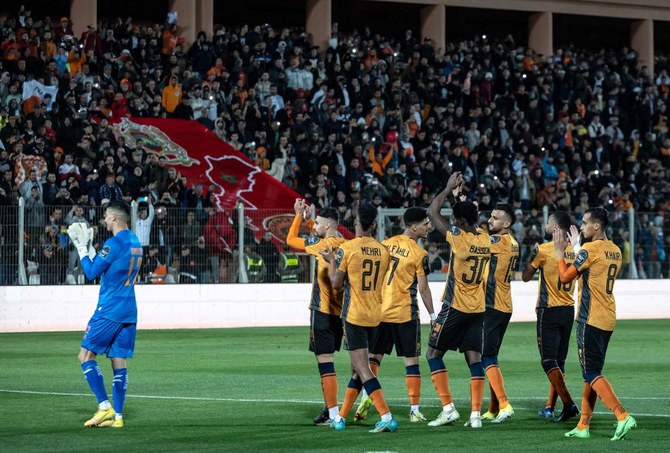
- The court said Thursday the two sides “are currently exchanging written submissions”
- The dispute already affected the teams’ semifinal of the CAF Confederation Cup
GENEVA: A soccer politics dispute between Algeria and Morocco over a map of disputed Western Sahara territory on a team jersey will go to a full appeal hearing at the Court of Arbitration for Sport.
The court said Thursday the two sides “are currently exchanging written submissions” and set no timetable for appointing a panel of judges and setting a date for a hearing.
The Algerian soccer federation and the USM Alger club from Algiers are challenging a decision by the Confederation of African Football to let Moroccan club RS Berkane wear a team jersey that includes disputed territory on a map of Morocco.
The dispute already affected the teams’ semifinal of the CAF Confederation Cup, in which USM Alger are the defending champion. Neither semifinal game scheduled on April 21 and 28 was played and both were awarded by CAF as 3-0 wins to Berkane.
Berkane are scheduled to play the two-leg final on May 12 and 19 — against Zamalek of Egypt — and the court did not indicate Thursday if the Algerian appeal will be judged before those games.
Western Sahara is a former Spanish colony annexed by Morocco in 1975. The United Nations brokered a ceasefire between Morocco and the pro-independence Polisario Front, which is supported by Algeria, that held until four years ago.
Algeria cut diplomatic ties with Morocco in 2021.
The laws of soccer state that “equipment must not have any political, religious or personal slogans, statements or images.”
Berkane arrived for the April 21 game in Algiers and had their team uniforms seized at the airport by Algerian authorities.
CAF refused an Algerian request to prohibit the shirts and, after Berkane refused to wear replacement shirts provided by USM Alger, the game did not go ahead.
CAF ruled the Algerian club were in breach of competition rules and Berkane were awarded a 3-0 win by default.
An urgent appeal by the Algerians to suspend CAF’s ruling on the shirt was denied last week by the sports court in Lausanne, Switzerland.
On April 28, USM Alger went to Berkane’s stadium for the second leg but refused to play if the hosts wore the jerseys with the map. CAF awarded a second default win to Berkane.
The full appeal in the case has now been brought against CAF, the Moroccan soccer federation and Berkane. One of the African soccer body’s most influential officials, FIFA Council member Fouzi Lekjaa, is president of the Moroccan federation and a former president of the Berkane club.
Saudi Smash 2024 draw held in Jeddah

- Ceremony signals start of weeklong table tennis competition
- ‘It is wonderful to be here in Saudi Arabia,’ Egyptian Omar Assar says
JEDDAH: The draw for the ITTF World Table Tennis Championships Saudi Smash 2024 took place on Thursday.
The draws for the men’s and women’s singles, each of which has 64 players, and the doubles categories, with 24 pairs in each, were held at the Infinity Arena, Sports Hall King Abdullah Sports City in Jeddah.
The tournament, which opens on Saturday and runs through May 11, is part of the WTT Grand Smash series.
Among the notable names in the draw were the men’s and women’s world No. 1s Wang Chuqin and Sun Yingsha of China, Brazil’s Bruna Takahashi and Egpyt’s Omar Assar.
Assar, who made history by becoming the first Egyptian player to reach the quarterfinals of a World Championship, said: “It is wonderful to be here in Saudi Arabia and looking forward to being part of this eagerly awaited tournament.”
Wang said: “It is really a tough competition but I am ready to compete until the end.”
The competition’s total prize pool of $2 million is the highest ever for an officially sanctioned event.
Other top players taking part include Felix Lebrun of France, Shin Yubin of South Korea, Hana Goda of Egypt and Dang Qiu of Germany.
Largest ever refugee team to compete at Paris Olympics-IOC
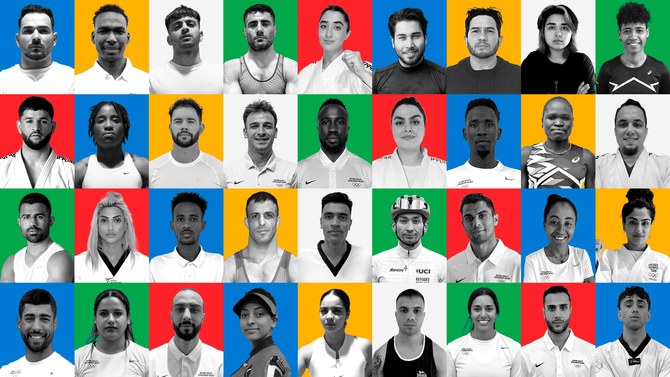
- The athletes, from countries including Syria, Sudan, Iran and Afghanistan, will compete across 12 sports in Paris
- IOC President Thomas Bach said: “This will send a message of hope to the more than 100 million displaced people around the world“
LAUSANNE: The International Olympic Committee (IOC) on Thursday unveiled its largest refugee Olympic team to date for the Paris 2024 Games, with 36 athletes from 11 different countries.
The athletes, from countries including Syria, Sudan, Iran and Afghanistan, will compete across 12 sports in Paris, the third time such a team has formed for the Summer Olympics.
“With your participation in the Olympic Games, you will demonstrate the human potential of resilience and excellence,” IOC President Thomas Bach said during the team’s announcement.
“This will send a message of hope to the more than 100 million displaced people around the world.”
For the first time, the team will compete under its own emblem.
The IOC unveiled its first refugee team for the Rio 2016 Olympics with 10 athletes to raise awareness of the issue as hundreds of thousands of people were pouring into Europe from the Middle East and elsewhere escaping conflict and poverty.
The team that competed at the Tokyo 2020 Olympics, held in 2021 due to the COVID-19 pandemic, was already almost three times as big as the inaugural team at the Rio Games, with a total of 29 athletes competing in 12 sports.
The Paris Olympics refugee team announcement comes shortly after Anjelina Nadai Lohalith, who ran as a refugee athlete in the 1,500 meters at the 2016 and 2021 Olympics, was suspended after testing positive for a banned substance.
The continuous rise in value of the Indian Premier League
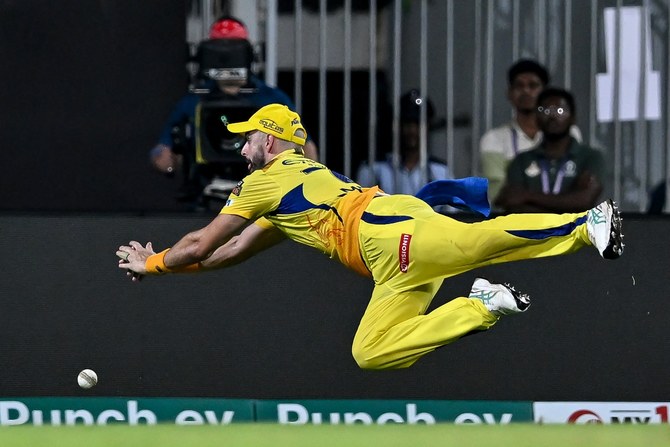
In the aftermath of the Punjab Kings’ record chase of 262 runs on April 26, team captain Sam Curran, remarked that the Indian Premier League “(is) becoming a bit like baseball, isn’t it?”
This was likely a moment that opponents of the IPL had predicted and feared — and, conversely, one that proponents of the IPL and T20 cricket in general relished.
T20 cricket is in line with the age of fast food. Instantly consumable, quickly forgotten and underpinned by mass advertising and high-profile personalities. Around the world, its sponsors include KFC for Australia’s Big Bash League, the very title encapsulating the format’s frenzy.
In England, the Hundred has a five-year deal with KP Snacks. Given governmental policy to reduce consumption of products that are high in fat, salt and sugar, the partnership has drawn criticism.
Meanwhile, in South Africa, SA20’s title sponsor is Betway, one of a growing number of betting companies associated with cricket. In the IPL, there is a myriad of sponsors. The title one, Tata, is paying $300 million between 2024 and 2028. Then there are three associate partners — My11Circle, Angel One and RUPay — plus an official broadcaster in Star Sports, official digital streaming partner JioCinema, official strategic timeout partner CEAT and an umpire partner in Paytm.
Each franchise team has a plethora of principal partners, associate partners, media partners and merchandise partners. These represent a broad range of different industry sectors which boost the brand value of the franchises. According to brand valuation consultancy Brand Finance, the value of the ten franchises at the end of the 2023 season ranged from $43.7 million to $87 million. The estimated brand value of the IPL was $10.7 billion.
Estimates of brand value are derived differently by different bodies. This is because brands are not tangible assets — they are subject to beliefs, perceived reputation, trust and experience. Their value lies in how consumers associate with the brand and how it influences their behavior. Attempts to quantify these factors require measurable elements such as trademarks, logos, taglines, visual assets, digital assets, customer retention and social media engagement levels.
Since it began 17 years ago, the IPL has generated all of these in abundance. Along with experience and engagement within the stadiums, an exponential growth in viewership reached close to 500 million unique viewers in 2023. The new media rights regime in 2024 has created further growth, with the Disney Star Network acquiring broadcast rights for all IPL matches in 2024. Live broadcast of the first 18 attracted over 400 million viewers, a 17 percent like-for-like increase over 2023.
There is a big shift in live streaming, with Viacom’s JioCinema awarded digital streaming rights in the 2024-27 cycle. In 2023 it streamed the entire IPL season for free on its mobile app and website, a feature continued into 2024. The move took many by surprise but enabled it to set a record for the highest concurrent viewership for a live-streamed event — some 32 million viewers tuned in to watch the final. Now, digital streaming appears to be gaining momentum over traditional TV broadcasting with IPL viewers, depending on market segment. This can only increase as technology advances and accessibility improves.
As a result, brand value estimates after the 2024 edition are likely to be affected. Close inspection of existing estimates reveals the different methodologies in use. Cost-based valuations focus on how much it has taken to build the brand. Market-based valuations take account of how much sales of similar brands have raised. Income-based valuations focus on how much money the brand brings into the organization compared with non-branded similar products for services. Customer-based valuations analyze existing customers and predict future consumption patterns.
Another approach is the relief from royalty method, used by global investment bank Houlihan Lokey. This calculates value based on hypothetical royalty payments that would be saved by owning an asset rather than licensing it. In 2023, this produced a brand value estimate for the IPL of $3.2 billion — a difference of some $10.7 billion compared with other estimates. The methodology also produces different estimates of the franchise brand values. In this case, they are in a higher range of $83 million to $212 million, with a slightly different ranking.
Houlihan Lokey also undertook a valuation of the IPL’s value as a business, based on the standard discounted cash flow technique. This amounted to $15.4 billion in 2023, an increase of 80 percent over 2022. Most of this can be attributed to the renewal of the media rights deal covering 2023-2027, worth three times more than the 2017-2022 cycle. It is reasonable to assume that, given the year-on-year increases in viewership, the IPL will be able to command even more enhanced terms in the next cycle.
Intuitively, this makes the use of DCF techniques understandable. Under normal circumstances, the IPL can be reasonably sure of its future revenue streams. Once they are expressed in terms of present values, investors can assess what rate of return they are likely to achieve. Ultimately, returns on investment and profits are more important to stakeholders than differences in brand valuations, although the franchisees remain committed to brand enhancement through fan engagement, association with star players and top sponsors.
Since 2008, the IPL has established itself as a global phenomenon and it has done so in a relatively short time. It attracts millions of fans and viewers, providing instant entertainment. All the signs are that it will continue to grow through increased sponsorship, viewer numbers and media rights income which, in turn, proliferates advertising revenue for the media. This is big business and looks unstoppable, but it may morph into a caricature of the game from which it took its roots.



